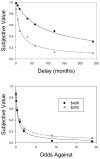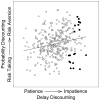How many impulsivities? A discounting perspective
- PMID: 23344985
- PMCID: PMC3893105
- DOI: 10.1002/jeab.1
How many impulsivities? A discounting perspective
Abstract
People discount the value of delayed and uncertain outcomes, and how steeply individuals discount is thought to reflect how impulsive they are. From this perspective, steep discounting of delayed outcomes (which fails to maximize long-term welfare) and shallow discounting of probabilistic outcomes (which fails to adequately take risk into account) reflect the same trait of impulsivity. Despite the fact that a hyperboloid function describes the discounting of both delayed and probabilistic outcomes, there is considerable evidence that the two kinds of discounting involve different processes as well as separate impulsivity traits. Several manipulations differentially affect delay and probability discounting, and correlational studies show that how steeply one discounts delayed rewards is relatively independent of how steeply one discounts probabilistic rewards. Moreover, people's discounting of delayed money and health outcomes are uncorrelated as are discounting of real, consumable rewards and hypothetical money. These results suggest that even within delay discounting, there may be multiple 'impulsivities,' each of which may be important for understanding a different aspect of decision making. Taken together, the pattern of findings reviewed here argues for a more nuanced view of impulsivity than that which is usually assumed in discounting research.
© Society for the Experimental Analysis of Behavior.
Figures



Similar articles
-
Delay and probability discounting by drug-dependent cocaine and marijuana users.Psychopharmacology (Berl). 2016 Jul;233(14):2705-14. doi: 10.1007/s00213-016-4316-8. Epub 2016 May 14. Psychopharmacology (Berl). 2016. PMID: 27180181
-
Domain independence and stability in young and older adults' discounting of delayed rewards.Behav Processes. 2011 Jul;87(3):253-9. doi: 10.1016/j.beproc.2011.04.006. Epub 2011 May 6. Behav Processes. 2011. PMID: 21550384 Free PMC article.
-
Impulsivity and cigarette smoking: discounting of monetary and consumable outcomes in current and non-smokers.Psychopharmacology (Berl). 2014 Dec;231(23):4517-26. doi: 10.1007/s00213-014-3597-z. Epub 2014 May 13. Psychopharmacology (Berl). 2014. PMID: 24819731 Free PMC article.
-
Steep Discounting of Future Rewards as an Impulsivity Phenotype: A Concise Review.Curr Top Behav Neurosci. 2020;47:113-138. doi: 10.1007/7854_2020_128. Curr Top Behav Neurosci. 2020. PMID: 32236897 Review.
-
Delay discounting of different outcomes: Review and theory.J Exp Anal Behav. 2020 May;113(3):657-679. doi: 10.1002/jeab.589. Epub 2020 Mar 8. J Exp Anal Behav. 2020. PMID: 32147840 Free PMC article.
Cited by
-
Comparing hyperbolic, delay-amount sensitivity and present-bias models of delay discounting.Behav Processes. 2015 May;114:52-62. doi: 10.1016/j.beproc.2015.03.006. Epub 2015 Mar 18. Behav Processes. 2015. PMID: 25796454 Free PMC article.
-
Differential effects of d-amphetamine and atomoxetine on risk-based decision making of Lewis and Fischer 344 rats.Behav Pharmacol. 2019 Oct;30(7):605-616. doi: 10.1097/FBP.0000000000000500. Behav Pharmacol. 2019. PMID: 31503070 Free PMC article.
-
Discounting of delayed and probabilistic losses over a wide range of amounts.J Exp Anal Behav. 2014 Mar;101(2):186-200. doi: 10.1002/jeab.56. J Exp Anal Behav. 2014. PMID: 24745086 Free PMC article.
-
Can't wait to lose weight? Characterizing temporal discounting parameters for weight-loss.Appetite. 2015 Feb;85:8-13. doi: 10.1016/j.appet.2014.11.001. Epub 2014 Nov 7. Appetite. 2015. PMID: 25450897 Free PMC article.
-
The Use of Nonmonetary Outcomes in Health-Related Delay Discounting Research: Review and Recommendations.Perspect Behav Sci. 2024 Apr 29;47(2):523-558. doi: 10.1007/s40614-024-00403-7. eCollection 2024 Jun. Perspect Behav Sci. 2024. PMID: 39099748 Free PMC article. Review.
References
-
- Cairns JA. Health, wealth and time preference. Project Appraisal. 1992;7:31–40.
-
- Chapman GB. Temporal discounting and utility for health and money. Journal of Experimental Psychology: Learning, Memory, and Cognition. 1996;22:771–791. - PubMed
-
- Chapman GB, Elstein AS. Valuing the future: Temporal discounting of health and money. Medical Decision Making. 1995;15:373–386. - PubMed
Publication types
MeSH terms
Grants and funding
LinkOut - more resources
Full Text Sources

